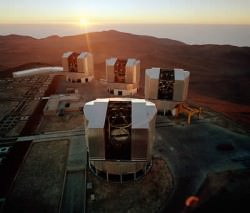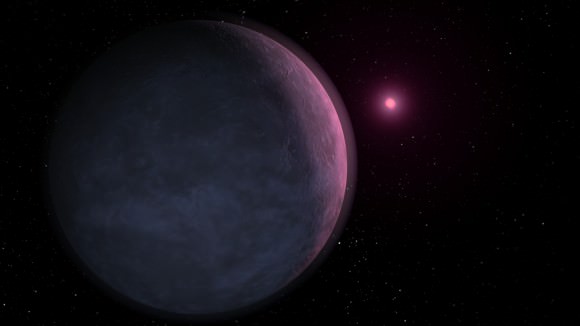[/caption]
In June of 2008, astronomers announced the finding of one of the smallest exoplanets yet around a normal star other than the Sun. The planet – believed to be a rocky exo-world — was found through a microlensing event, and was estimated to be 3.3 times the size of Earth, orbiting a brown dwarf star. But new analysis suggests the star may be larger than first thought, making the planet smaller than the original estimates. Astronomers say the exoplanet, called MOA-2007-BLG-192-L b could weigh just 1.4 Earths – less than half the original estimate. Observations over the next few months should be able to test the prediction.
Most known “exoplanets” are huge gas giants, hundreds of times Earth’s mass, and are discovered by detecting the wobble they induce in their parent stars.
But researchers found the planet and star using the gravitational microlensing technique. This is where two stars line up perfectly from our point of view here on Earth. As the two stars begin to line up, the foreground star acts as a lens to magnify and distort the light from the more distant star. By watching how this brightening happens, astronomers can learn a tremendous amount about the nature of both the foreground and background star.
In this case, there was an additional gravitational distortion from the planet orbiting the foreground star MOA-2007-BLG-192L, which astronomers were able to tease out in their data.
However, analyzing these events takes time, because there are so many variables to take into account, including the sizes of planet and star, their separation, and the distance from Earth.
Initially, the team believed that this host star was a brown dwarf – an object too small to sustain nuclear fusion, as normal stars do. That suggested MOA-2007-BLG-192-L b weighed 3.3 Earths.
But more recent observations suggest the parent star is actually heavier than first thought – a type of star called a red dwarf, team member Jean-Philippe Beaulieu of the Paris Astrophysical Institute reported last week at a meeting of the Royal Astronomical Society in London.
That suggests the planet weighs just 1.4 Earths. In size terms, that makes it a near twin of our own planet, closer in mass than any known planet except Venus.
“The result is important because this is the lowest-mass planet yet detected, and is extremely close to the mass of the Earth,” said Scott Gaudi of Ohio State University in Columbus. “Obviously, finding a true Earth-mass planet is one of the biggest goals of searches for exoplanets. We are very close to that goal now.”

The team will attempt to get more data on the parent star in April or May using the Very Large Telescope in northern Chile.
If their analysis is confirmed, it is an unclear whether the tiny planet could host any life. Because its host is a very dim red dwarf, the planet is likely to be frozen – even though it orbits at about the same distance as Venus from our Sun.
However, if the planet boasts a thick, insulating hydrogen atmosphere, it could sustain a habitable surface temperature, capable of supporting life of some kind.
Source: New Scientist


They always look for life on planets but what about life on the moonss of those planets?
Didn’t they just decribe Krypton?
Don’t forget that Venus and Mars are “earthlike”, too. Earthlike doesn’t always mean life-bearing.
Shame it was a one-chance-only lensing event!
Olaf Says:
January 19th, 2009 at 7:19 pm
” They always look for life on planets but what about life on the moonss of those planets?”
The thing is, just (just?!) being able to spot the planets in the first place is right on the bleeding edge of our current technological limitations. Moons surrounding other planets may harbour life, but it will be some time before we have the capability to start making these sorts of detections at all, let alone in-depth studies of them, for a variety of reasons.
Exollent news 🙂
they are out there, waiting for us to look a little farther…patiently waiting
I’m happy waiting for that day coming.
Kevin F. Says: Don’t forget that Venus and Mars are “earthlike”, too. Earthlike doesn’t always mean life-bearing.
yep! Considering all the unjustified expectations generated by the way of reporting the findings of methane on Mars by the media, would it not be much better to write that
“Exoplanet Could Be More Earth-sized Than Previously Thought”
instead of Earth-like?
What’s this about the star being larger than estimated. How does that work?
If detecting one planet took this much work and patience for the perfect line-up, I can’t help getting dizzy when thinking about all the stars sticking up there on the sky !!!
Why do the scientists keep playing games about extraterrestrial life by pretending to be looking for aliens when we have had proof right on this planet earth for over 60 years??
You cannot deny thousands of credible witness testimonies for decades. And there has been lots of physical evidence of landings and more, but that proof has always been botched up, usually on purpose to hide the truth.
The military was and still is covertly very interested in socalled UFOS for their technology and other secrets from more advanced cultures.
The goverment may have hidden the truth about aliens visiting earth in the past because they thought people couldn’t handle such knowledge, but that time is long past.
We are ready and need to know THE TRUTH NOW!
So stop playing around with distant planets that may or may not be like our earth and start investingating the aliens ON earth!
Tech Roach, I guess that there cannot be such many candidates in the sky to apply this method.
“Two stars line up perfectly from our point of view here on Earth. As the two stars begin to line up, the foreground star acts as a lens to magnify and distort the light from the more distant star.“
Absolutely fascinating – it can’t be that long before scientists really detect a true Earth-sized planet. Now, if such a planet had methane/abundant free oxygen signatures in its atmosphere… That truly would be another Earth.
Scientists actually have not been denying the fact that there is other life other than on earth.
Why I just read a book a little while ago that said there were small forms of worms and bacteria that lived on mars’ surface and that mars was almost exactly like earth until it dried up or something.
The worms used to live on Mars is what I meant.
You mean the nanofossils from the Mars meteorite found at the South Pole? The jury is still out on whether they are life or not, last I heard.
Hey megan – go peddle your cr- I mean ideas somewhere else.
Megan
Try the website: http://www.moronsandconspiracies.com
Acording to Exoplanetology, this report is wrong and the planet remains at 3.3 Me.
Stay tuned for the Kepler Mission, scheduled to launch on March 5. It’s designed specifically to find Earth-sized planets, using the transit method:
http://kepler.nasa.gov/